Archive for October, 2020
-
ALG Research on Eagle Bancorp
Eddy Elfenbein, October 21st, 2020 at 12:01 pmAt Seeking Alpha, ALG Research takes a close look at Eagle Bancorp.
Their thesis is largely similar to ours — that Eagle is a good bank and it’s historically undervalued. While ALG is neutral on the bank due to their legal issues, they do concede that the issues are probably near an end.
-
Earnings from Stepan and Silgan Holdings
Eddy Elfenbein, October 21st, 2020 at 9:13 amWe got our first two Buy List earnings reports this morning for the Q3 earning season.
First up is Stepan (SCL). The company earned $1.56 per share for Q3 which beat Wall Street’s consensus of $1.40 per share. The company also raised its dividend by 10.9% making it the 53rd annual dividend increase in a row. The quarterly dividend will rise from 27.5 cents to 30.5 cents per share. That makes the yield a little over 1%. The shares are about flat on the day.
Next up is Silgan (SLGN). For Q3, Silgan made $1.04 per share. That’s up 37% over last year’s Q3. Wall Street had been expecting 95 cents per share.
Silgan raised its full-year guidance range to $2.92 to $2.97 per share. The previous range was $2.70 to $2.85 per share. Last year, Silgan made $2.16 per share.
For Q4, Silgan now expects earnings of 47 to 52 cents per share. They made 38 cents per share for last year’s Q4.
CEO Tony Allott said, “While we are still completing our annual budget process for 2021, at this time we anticipate overall operating earnings for the Company remaining at these strong levels.”
Globe Life (GL) reports after the close.
-
Morning News: October 21, 2020
Eddy Elfenbein, October 21st, 2020 at 7:05 amWEF Says Machines Will Create More Jobs Than They Destroy But Warns of Pandemic ‘Double-Disruption’
The Fed’s $4 Trillion Lifeline Never Materialized. Here’s Why.
U.S. Banks Sweat Regulatory Exposure From Pandemic Loans
Google Antitrust Case to Turn On How Search Engine Grew Dominant
America’s Billionaires Tilting Toward Biden in Presidential Race
Big U.S. Treasuries Wagers Bet Against Election Fireworks
U.S. Retailers Secure Stores As Worries About Election Unrest Mount
Apartment Rents Are Plunging in the World’s Richest Cities. It’s Time For You to Negotiate
Snapchat Co-Founders Share $2.7 Billion Windfall
Disneyland and Other California Theme Parks Get Rules for Reopening
As Tropical Spots Reopen, Here’s What You Need to Know
Nick Maggiulli: Why Own Bonds When Rates are So Low?
Ben Carlson: Investors Need to Become More Comfortable With Volatility in Their Portfolios
Michael Batnick: Is Amazon In Trouble? & Animal Spirits: Bad Ideas
Howard Lindzon: Brick and Mortar Winners in a Post Covid World
Joshua Brown: Buy Stocks Now or After the Election?
Be sure to follow me on Twitter.
-
Housing Starts Rise in September
Eddy Elfenbein, October 20th, 2020 at 12:55 pmThis morning’s housing starts report showed a big increase. The Commerce Department said that housing starts rose 1.9% last month to a seasonally adjusted annual rate of 1.415 million units.
Single-family homebuilding, the largest share of the housing market, jumped 8.5% to a rate of 1.108 million units last month. But starts for the volatile multi-family housing segment fell 16.3% to a pace of 307,000 units.
Overall, housing starts increased 1.9% to a seasonally-adjusted annual rate of 1.415 million units last month. Data for August was revised down to a 1.388 million-unit pace from the previously reported 1.416 million. Groundbreaking activity rose in the West, South and Northeast, but fell in the Midwest.
Economists polled by Reuters had forecast starts increasing to a rate of 1.457 million units in September.It’s hardly a secret why. Mortgage rates continue to be very low.
The stock market is up so far today. The S&P 500 is up about 1%. Many of the cyclicals are leading.
-
Morning News: October 20, 2020
Eddy Elfenbein, October 20th, 2020 at 7:04 amChina Is Experiencing a Boom in Share Sales
After America First, Some Investors Bet On A Biden Boost Abroad
Oil Industry Turns to Mergers and Acquisitions to Survive
As Washington Scrambles for More Bailout Money, the Fed Sits on Mountain of Untapped Funds
Walmart Cranks Up Advertising Drive, With or Without TikTok
Intel Sells NAND Memory Chip Business to SK Hynix for $9 Billion
UBS Makes It Easier for Exiting Employees to Collect Bonuses
Offices Resort to Sensors in Futile Attempts to Keep Workers Apart
Many Stock Investors Are Too Young to Remember Black Monday in October 1987 — Why That’s A Problem
Chasing Illicit Money, Global Officials Circle a Puerto Rican Firm
Joshua Brown: Well This Is…Something
Ben Carlson: Opening An Investing Account For The Kids
Howard Lindzon: Momentum Monday…Black Monday Was 33 Years Ago Today
Be sure to follow me on Twitter.
-
Homebuilder Confidence Hits All-Time High
Eddy Elfenbein, October 19th, 2020 at 11:52 amThe nation’s homebuilders are seeing no fall chill in demand from buyers, and that has the industry more confident than ever.
Builder sentiment set a record high for the second month in a row, jumping to 85 in October on the NAHB/Wells Fargo Housing Market Index. September and October are the first two months the index has ever been above 80. Anything above 50 is considered positive. The index stood at 71 in October 2019.
All three components of the index either set records or matched their highest readings. Current sales conditions rose 2 points to 90. Sales expectations in the next six months increased 3 points to 88, and buyer traffic was unchanged at 74.
In a related note: Today’s mortgage rates fall even lower.
-
The Market Crash, 33 Years On
Eddy Elfenbein, October 19th, 2020 at 11:11 amToday is the 33rd anniversary of the 1987 stock market crash. As it turns out, that crash happened on a Monday.
The Dow fell 508 points for a total loss of over 22.6%. That was the largest drop in market history. Today, that would be like a drop of more than 6,000 points.
In fact, with the modern circuit breakers, that record may never be broken. Today, if the market falls over 20%, then the exchange is shut down for the day.
People often ask, “so what caused the crash?” At the time, the popular answer was program trading. But that’s misleading. A number of very unusual events happened just before the crash.
For example, over that weekend in 1987, parts of England were hit with the worst storm in 300 years. The intensity of the storm caught forecasters off guard.
That weekend, James Baker had gone on the Sunday talk shows and criticized Germany for its recent rate hike. An unnamed Treasury official said that we would “drive the dollar down” if necessary. This led European markets to fall on Monday.
Also, a tax bill had just been introduced in the House Ways and Means Committee that would severely limit tax deductions for interest paid on debt used to finance mergers or hostile takeovers (which had been running rampant throughout 1987).
Alan Greenspan was new on the job as Fed chair, and he raised interest rates just before the crash.
The day of the crash, many stocks couldn’t open for trading, yet the futures markets were working. As a result, a big gap opened between the two. By 10 am, 95 S&P 500 stocks, representing 30% of the index, were still not open.
With the 1987 crash, the market temporarily gave back its recent gains. Here I’ve altered the chart slightly, and it doesn’t look so unusual:
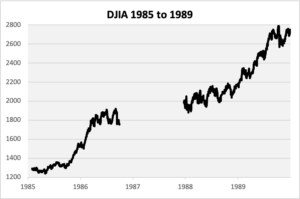
If you had been Rip Van Winkle and slept though the whole thing, the chart above would look perfectly normal. Fortunately, the market break had little impact on GDP:
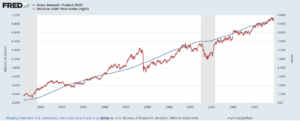
Starting from the day before the crash, the Wilshire 5000 Total Return Index is up 30 fold.
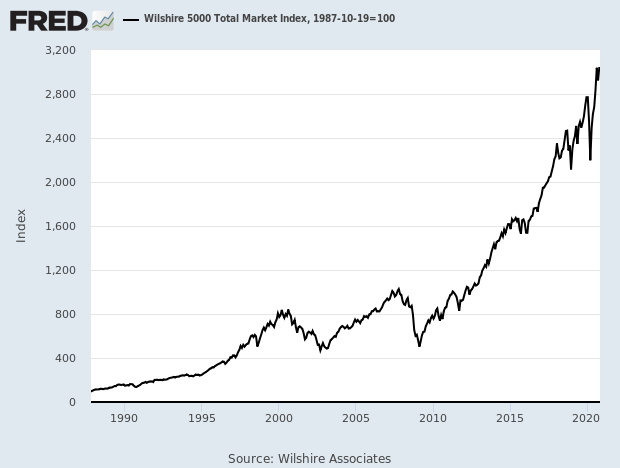
-
Morning News: October 19, 2020
Eddy Elfenbein, October 19th, 2020 at 7:07 amWith Covid-19 Under Control, China’s Economy Surges Ahead
Lockdowns In Europe Are A Warning to the United States
EU Set To Gain WTO Clearance For U.S. Tariffs Next Week
Weakened U.S. Consumer Watchdog Expected to Bite Back If Biden Wins Election
For Long-Term Investors, Small Things Like Presidential Elections Don’t Matter
Conoco to Buy Concho for $9.7 Billion, Creating Permian Oil Giant
World’s Biggest Fracker Sees Signs of Rebirth as Slump Bottoms
Almost 60% of Mutual Fund Assets Will Be ESG by 2025, PwC Says
Atari Is Launching A Cryptocurrency Along With Its New Gaming Console
Disney Adds Warnings for Racist Stereotypes to Some Older Films
Jeff Miller: Weighing the Week Ahead: Will Strong Earnings Confirm an Economic Rebound?
Joshua Brown: Are Investors Getting Smarter? & Losing Money Is The Coolest!
Ben Carlson: What If The 4% Rule For Retirement Withdrawals is Now the 5% Rule? & You Paid Off Your Mortgage. Now What?
Michael Batnick: Animal Spirits: What’s in an Index? & Trading Through the Pandemic
Be sure to follow me on Twitter.
-
Retail Sales Rose 1.9% in September
Eddy Elfenbein, October 16th, 2020 at 11:47 amThis morning’s retail sales report showed a nice increase of 1.9%. That beat Wall Street’s forecast of 0.7%. The report covered the month of September. If you don’t include autos, then retail sales were up by 1.5%. That beat estimates of 0.4%. Retail sales is important because it’s seen as a proxy for consumer spending.
The stock market is up cautiously today. So far, more conservative sectors like health care and utilities are leading the market.
The data indicate Americans ramped up spending as kids returned to school and adults hunkered down to keep working at home amid the COVID-19 pandemic. Last month’s growth improved from August’s 0.6 percent rise even though expanded unemployment benefits and other stimulus measures have run dry in recent months.
“Despite unemployment benefits expiring for millions of Americans, today’s retail sales figure shows us there is still some gas in the tank for the consumer,” said Charlie Ripley, senior investment strategist for Allianz Investment Management.
September’s total retail sales were 5.4 percent above where they were a year ago even though the pandemic has put millions of Americans out of work and caused a record contraction in the US economy this spring.
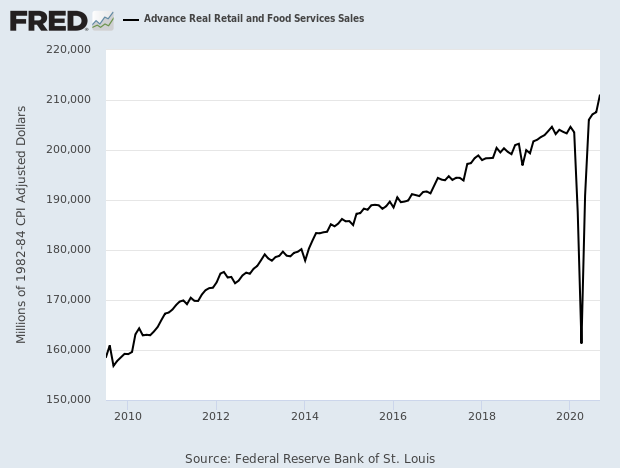
-
CWS Market Review – October 16, 2020
Eddy Elfenbein, October 16th, 2020 at 7:08 am“The best time to invest is when you have money.” – John Templeton
It’s the time of year for witches, tricks, black magic, hexes and sorcery. That’s right, it’s Q3 earnings season.
Over the next weeks, most of Corporate America will report how well it did during July, August and September. Or perhaps, how well it didn’t do.
We’ve already gotten our first look at some earnings reports. The big banks usually go first, and the results look pretty good. Goldman Sachs, for example, beat Wall Street’s consensus by more than 70%. For the moment, the big banks aren’t allowed to raise their dividends or buy back stock. I think that regulation may be lifted early next year. (Eagle is a small fry, so that’s why it was able to resume its buybacks.)
The stock market had a strong day on Monday but lost ground on Tuesday, Wednesday and Thursday. The folks in Washington seem hopelessly deadlocked on any stimulus deal. It looks like whatever happens, it will come after the election. There are also some concerns of a coronavirus spike in Europe.
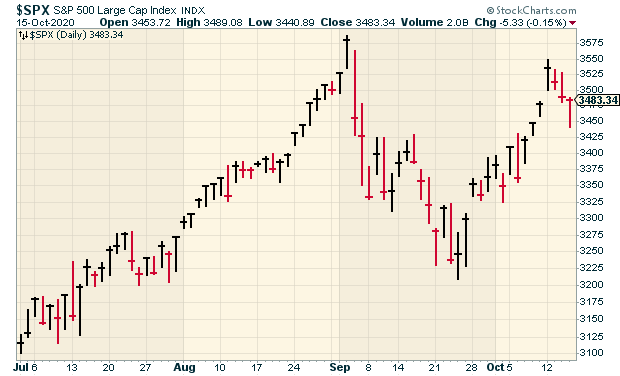
I’m pleased to see that our Buy List is holding up well. Since the market peaked on September 2, the S&P 500 has fallen 2.72%, while our Buy List is down just 0.20%. That tells me the high-quality stocks are serving as a safe harbor for nervous investors.
In this week’s issue, I’ll preview the first six of our Buy List stocks that are due to report earnings next week. I’m expecting good results. Last earnings season, every single Buy List stock beat earnings except one, and they reported inline.
Later on, I’ll discuss the big reorganization announcement from Disney. The Mouse House is apparently following after Netflix. I’ll tell you what it all means. But first let’s take a look at our updated Earnings Calendar.
Updated Buy List Earnings Calendar
Here’s a look at our upcoming Q3 earnings. I’ve listed each stock, its earnings date and Wall Street’s consensus. I’m still waiting to hear when Middleby and Broadridge will report. Both will probably report sometime in early November.
Stock Ticker Date Estimate Result Globe Life GL 21-Oct $1.75 Silgan SLGN 21-Oct $0.95 Stepan SCL 21-Oct $1.40 Check Point Software CHKP 22-Oct $1.53 Danaher DHR 22-Oct $1.36 Eagle Bancorp EGBN 22-Oct $0.81 AFLAC AFL 27-Oct $1.13 Fiserv FISV 27-Oct $1.16 Sherwin-Williams SHW 27-Oct $7.75 Cerner CERN 28-Oct $0.71 Church & Dwight CHD 29-Oct $0.67 Intercontinental Exchange ICE 29-Oct $0.99 Moody’s MCO 29-Oct $2.10 Stryker SYK 29-Oct $1.40 Trex TREX 2-Nov $0.37 Ansys ANSS 4-Nov $1.26 Becton, Dickinson BDX 5-Nov $2.52 Hershey HSY 6-Nov $1.70 Disney DIS 12-Nov -$0.71 Broadridge Financial Sol BR TBA $0.63 Middleby MIDD TBA $1.02 Six Buy List Earnings Previews
We have six Buy List stocks due to report next week: three on Wednesday and three more on Thursday.
In July, Globe Life (GL) reported fiscal-Q2 operating earnings of $1.65 per share. That beat expectations of $1.53 per share. The company also narrowed its operating income guidance for this year. The previous range was $6.65 to $7.25 per share. Now Globe Life sees earnings ranging from $6.80 to $7.04 per share.
If Globe Life’s outlook is correct, that means the shares are going for less than 12 times earnings. This tends to be one of the most stable stocks in our portfolio. GL is currently down 21% for us this year. It’s been dragged down with most of the financial sector. For Q3, Wall Street expects $1.75 per share.
Silgan (SLGN) has been an impressive stock for us this year. I’m almost always surprised when I see which stocks are our big winners each year.
For Q2, the metal-container folks earned 85 cents per share. That beat expectations by 20 cents per share. This was the strongest quarter in the company’s history. Net sales were up by 7.6% to $1.18 billion. The stock popped on the news (see July in the chart below).
Silgan also did something very rare for 2020. The company increased guidance. Silgan now sees full-year earnings of $2.70 to $2.85 per share. Silgan also increased its free-cash-flow estimate for this year from $275 million to $330 million. For Q3, Wall Street expects Silgan to report earnings of 95 cents per share.
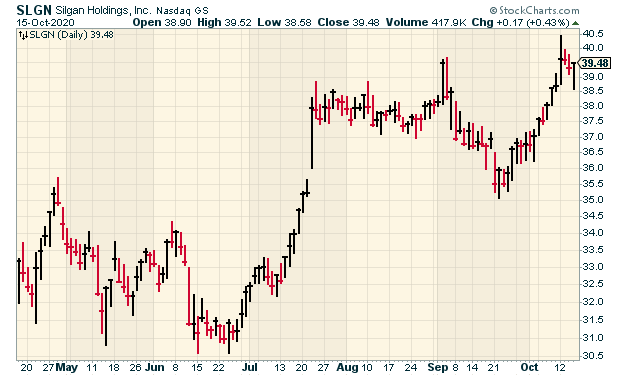
Stepan (SCL), our favorite chemical company, had a blow-out earnings report for Q2. The company raked in $1.65 per share. That beat estimates by 45 cents per share. The consensus for next week’s report is for $1.40 per share. Shares of Stepan are within 4% of a new 52-week high. The company has increased its dividend for the last 52 years in a row.
Check Point Software (CHKP) is due to report next Thursday. Three months ago, the Israeli cyber-security company reported Q2 earnings of $1.58 per share. That beat expectations by 14 cents per share.
The numbers were pretty good. Quarterly revenue rose 4% to $506 million. Wall Street had been expecting $488 million. Cash flow from operations increased by 8% to $252 million. During Q2, Check Point bought back 3.1 million shares for a total cost of $325 million. The company continues to have a solid balance sheet, which is something I like to see.
Interestingly, Check Point said that cyber-attacks have increased during the pandemic. In May, the company documented 192,000 coronavirus-related cyber-attacks a week.
On Thursday, Check Point snapped a six-day winning streak. For next week, Wall Street expects earnings of $1.53 per share.
Danaher (DHR) has become a very big winner for us this year. The stock hit a new 52-week high earlier this week. At Thursday’s close, DHR is up 47% for us this year. On our Buy List, that’s second only to Trex (TREX), which is up 74% this year.
Three months ago, Danaher said that Q2 earnings increased 32% to $1.44 per share. Wall Street had been expecting $1.09 per share. Revenue increased 19% to $5.3 billion.
For Q3, Danaher sees revenue growth “in the mid- to high-single digit range.” CEO Thomas P. Joyce, Jr., said, “We are very pleased with our second-quarter results—especially in such a challenging environment. Our solid revenue growth, strong cash-flow generation and more than 30% adjusted EPS growth are a testament to our team’s commitment to the Danaher Business System and the outstanding portfolio of businesses that comprise Danaher today.”
Shares of Danaher have drifted above our $212 Buy Below. I’ll probably adjust it next week, but I want to see the earnings report first.
Eagle Bancorp (EGBN) is also set to report next Thursday. We’ve been very patient with this one, and it looks like the story is finally turning in our favor. To recap, as a bank Eagle is a well-run outfit. The problem is that possible scandals by previous management have inflated its lawyer bills and depressed the stock.
The stock is currently going for about nine times this year’s earnings, and that’s after a nice rally. In one eleven-day stretch, Eagle rallied over 21%. The bank recently said it’s reinstating its share-buyback program. During Q1, the bank halted all share buybacks. Eagle wasn’t alone. A lot of companies did this at the start of the pandemic.
Through the end of this year, management has been authorized to buy as much as 5% of Eagle’s outstanding shares. As of Jun 30, Eagle had 460,000 shares remaining under the buyback authority.
Only five analysts have estimates for Q3. The consensus is for Eagle to report earnings of 81 cents per share. At its current share price, Eagle yields just under 3%.
What to Make of Disney’s Reorg
Last week, Dan Loeb called on Disney (DIS) to suspend its dividend. Loeb is a well-known activist investor. Currently, Disney pays a semi-annual dividend of 88 cents per share each July and December. The company skipped its dividend this summer.
An annual dividend of $1.76 per share works out to over $3 billion per year. Loeb wants Disney to put that cash into its streaming service.
But through it all, Disney’s streaming business has been a notable success story. After making its debut last November, Disney+ had 60.5 million subscribers worldwide by August—well ahead of analysts’ and Disney’s own forecasts. Its other offerings are Hulu, with 36 million, and ESPN+, with 9 million. Next year, Disney is also planning to add an international streaming service similar to Hulu, to be called Star.
Barron’s pointed out that this is the opposite of what activist investors usually do. They’re known for pursuing short-term profits at the expense of long-term financial health. This time, Loeb is looking at the long term.
I understand Loeb’s thinking, but I think he’s premature. In my view, it all comes down to Covid-19. If a vaccine comes out tomorrow, then Disney’s troubles go away. Disney is a company almost perfectly made to be impacted by the coronavirus.
Relatedly, I floated the idea on Twitter recently of Disneyland leaving California. Most Twitterers responded by saying this was a farfetched idea. Probably so. Still, the mess of Covid has allowed people to rethink what their businesses are about, and unthinkable options are now thinkable.
Disney is in the hot seat after announcing that it’s laying off 28,000 workers. Senator Elizabeth Warren, for example, criticized Disney for laying off employees while protecting executive salaries. To be fair, Disney has continued healthcare benefits to furloughed employees.
The big news this week is that Disney announced a major reorganization. The company is “centralizing its media businesses into a single organization that will be responsible for content distribution, ad sales and Disney+.” In my opinion, this is a reflection of the importance of streaming to Disney’s business. The company, in many ways, is shifting towards a business model of a company like Netflix. Kareem Daniel will be in charge of the new media and entertainment distribution group.
The announcement worked. Shares of Disney popped 3.7% on the news. I think investors like the idea of owning the “next Netflix,” and Disney getting an earnings multiple like Netflix. Still, this doesn’t solve Disney’s major near-term headache of being overly reliant on travel and sports—in other words, the things most impacted by Covid. The reorg is a provocative move, but don’t let it mislead you as to where Disney’s major concerns are.
Disney is due to report Q3 earnings on November 12, and investor day is on December 10.
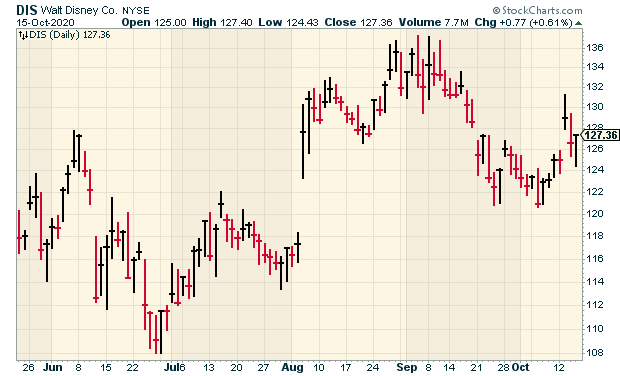
That’s all for now. Next week will be dominated by earnings. On Monday, we’ll get the NAHB homebuilder’s index. Then on Tuesday, housing starts and building permits are reported. On Thursday, the existing-home sales report comes out. Also on Thursday, we’ll get another jobless-claims report. The last one came in at 898,000. Be sure to keep checking the blog for daily updates. I’ll have more market analysis for you in the next issue of CWS Market Review!
– Eddy
-
-
Archives
- June 2025
- May 2025
- April 2025
- March 2025
- February 2025
- January 2025
- December 2024
- November 2024
- October 2024
- September 2024
- August 2024
- July 2024
- June 2024
- May 2024
- April 2024
- March 2024
- February 2024
- January 2024
- December 2023
- November 2023
- October 2023
- September 2023
- August 2023
- July 2023
- June 2023
- May 2023
- April 2023
- March 2023
- February 2023
- January 2023
- December 2022
- November 2022
- October 2022
- September 2022
- August 2022
- July 2022
- June 2022
- May 2022
- April 2022
- March 2022
- February 2022
- January 2022
- December 2021
- November 2021
- October 2021
- September 2021
- August 2021
- July 2021
- June 2021
- May 2021
- April 2021
- March 2021
- February 2021
- January 2021
- December 2020
- November 2020
- October 2020
- September 2020
- August 2020
- July 2020
- June 2020
- May 2020
- April 2020
- March 2020
- February 2020
- January 2020
- December 2019
- November 2019
- October 2019
- September 2019
- August 2019
- July 2019
- June 2019
- May 2019
- April 2019
- March 2019
- February 2019
- January 2019
- December 2018
- November 2018
- October 2018
- September 2018
- August 2018
- July 2018
- June 2018
- May 2018
- April 2018
- March 2018
- February 2018
- January 2018
- December 2017
- November 2017
- October 2017
- September 2017
- August 2017
- July 2017
- June 2017
- May 2017
- April 2017
- March 2017
- February 2017
- January 2017
- December 2016
- November 2016
- October 2016
- September 2016
- August 2016
- July 2016
- June 2016
- May 2016
- April 2016
- March 2016
- February 2016
- January 2016
- December 2015
- November 2015
- October 2015
- September 2015
- August 2015
- July 2015
- June 2015
- May 2015
- April 2015
- March 2015
- February 2015
- January 2015
- December 2014
- November 2014
- October 2014
- September 2014
- August 2014
- July 2014
- June 2014
- May 2014
- April 2014
- March 2014
- February 2014
- January 2014
- December 2013
- November 2013
- October 2013
- September 2013
- August 2013
- July 2013
- June 2013
- May 2013
- April 2013
- March 2013
- February 2013
- January 2013
- December 2012
- November 2012
- October 2012
- September 2012
- August 2012
- July 2012
- June 2012
- May 2012
- April 2012
- March 2012
- February 2012
- January 2012
- December 2011
- November 2011
- October 2011
- September 2011
- August 2011
- July 2011
- June 2011
- May 2011
- April 2011
- March 2011
- February 2011
- January 2011
- December 2010
- November 2010
- October 2010
- September 2010
- August 2010
- July 2010
- June 2010
- May 2010
- April 2010
- March 2010
- February 2010
- January 2010
- December 2009
- November 2009
- October 2009
- September 2009
- August 2009
- July 2009
- June 2009
- May 2009
- April 2009
- March 2009
- February 2009
- January 2009
- December 2008
- November 2008
- October 2008
- September 2008
- August 2008
- July 2008
- June 2008
- May 2008
- April 2008
- March 2008
- February 2008
- January 2008
- December 2007
- November 2007
- October 2007
- September 2007
- August 2007
- July 2007
- June 2007
- May 2007
- April 2007
- March 2007
- February 2007
- January 2007
- December 2006
- November 2006
- October 2006
- September 2006
- August 2006
- July 2006
- June 2006
- May 2006
- April 2006
- March 2006
- February 2006
- January 2006
- December 2005
- November 2005
- October 2005
- September 2005
- August 2005
- July 2005
 Eddy Elfenbein is a Washington, DC-based speaker, portfolio manager and editor of the blog Crossing Wall Street. His
Eddy Elfenbein is a Washington, DC-based speaker, portfolio manager and editor of the blog Crossing Wall Street. His